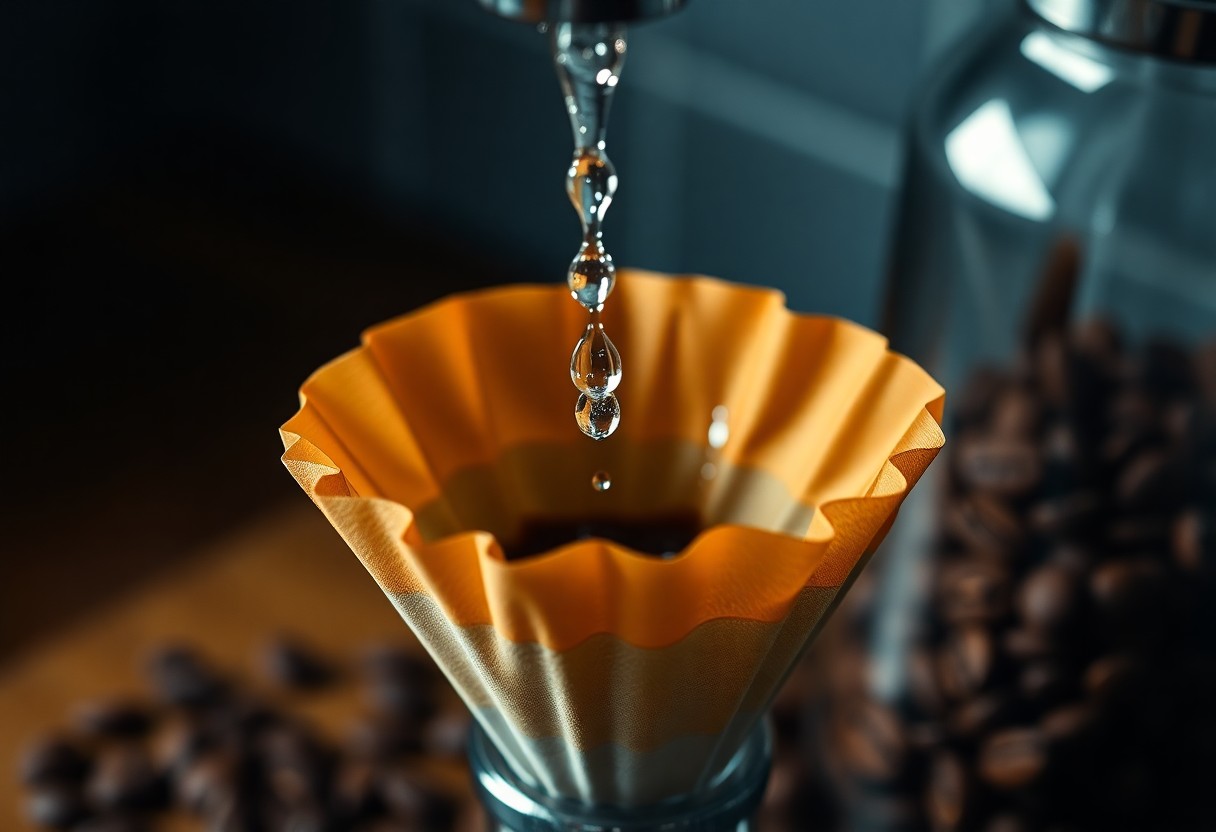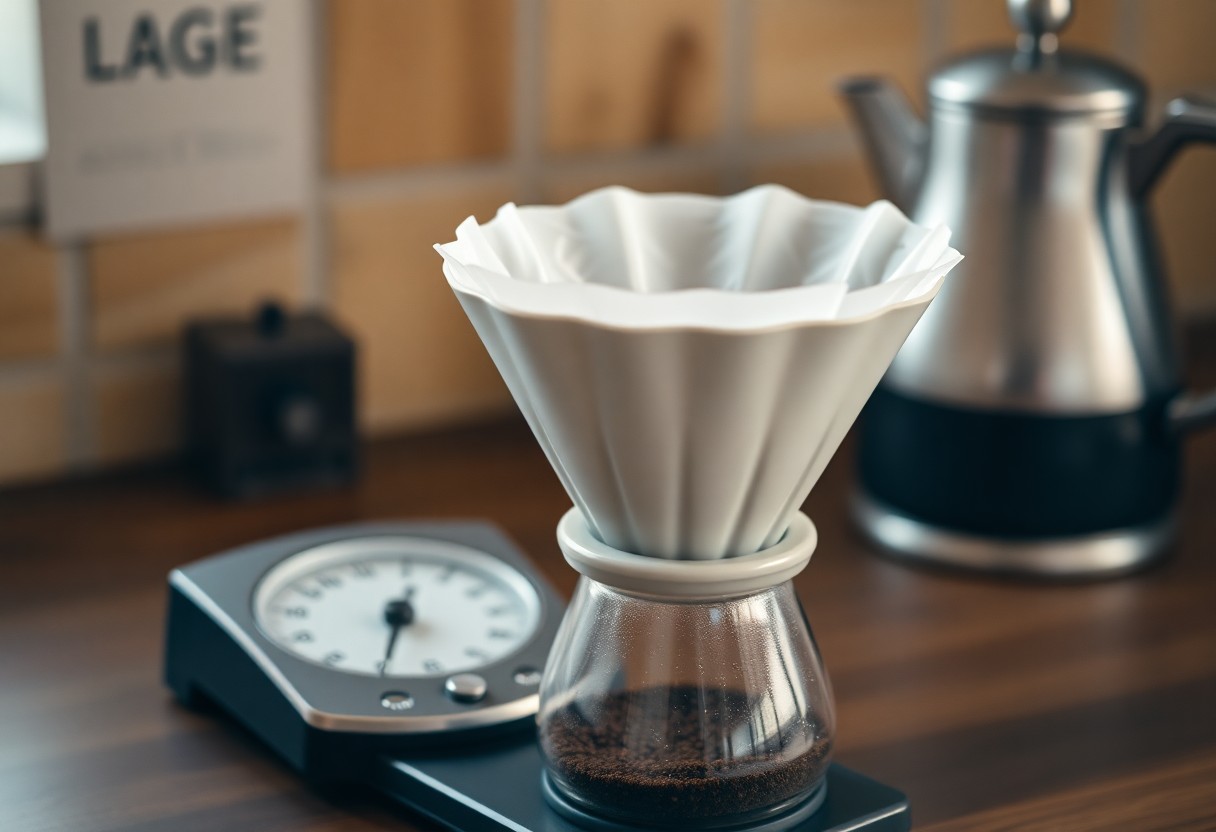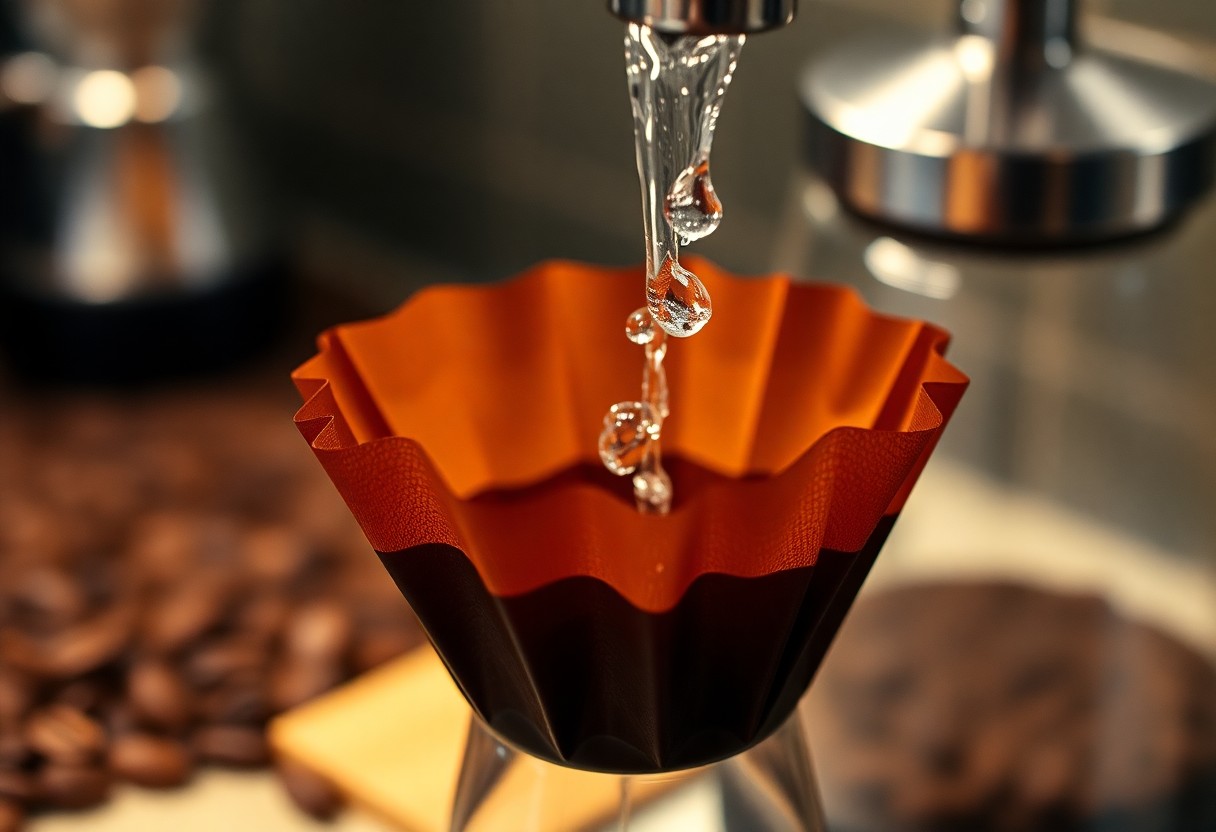You might not realize that pre-wetting your coffee filter can significantly alter your brew’s strength and flavor profile. By moistening the filter before use, you can help eliminate any potential paper taste, ensuring that your coffee’s unique qualities shine through. Additionally, this simple step can enhance extraction, resulting in a more balanced cup. However, be cautious; if not done correctly, it could lead to under-extraction or over-extraction, compromising your brew. Understanding the impact of this technique allows you to fine-tune your coffee-making process for optimal results.
Key Takeaways:
- Pre-wetting coffee filters can help eliminate any papery taste, enhancing the overall flavor profile of your brew.
- This practice allows for better flow of water through the coffee grounds, potentially leading to a more uniform extraction and impacting brew strength.
- Pre-wetting may result in a slightly milder cup, as it pre-saturates the filter and allows for more efficient extraction of solubles from the coffee grounds.
The Chemistry of Coffee Extraction
In the intricate process of brewing coffee, extraction is fundamental to achieving the desired flavor profile. The myriad chemical compounds in coffee beans release their flavors when hot water interacts with them, leveraging principles of solubility and kinetics. You can manipulate extraction by controlling various factors, directly influencing the coffee’s body, acidity, and bitterness. Understanding these scientific aspects can help you master your brewing methods to produce coffee that suits your preference.
Understanding Solubility and Flavor Compounds
Flavor compounds in coffee are predominantly soluble in water. During brewing, the solubility of these compounds changes with time and temperature, impacting overall flavor. Compounds like caffeine and acids extract quickly, while oils and aromatics take longer to dissolve. You should be aware that over-extraction can lead to unpleasant bitterness, while under-extraction leaves your cup sour and weak.
The Role of Water Temperature and Contact Time
Water temperature significantly impacts the efficiency of extraction. Typically, optimal temperatures for brewing range from 195°F to 205°F (90°C to 96°C). When water is too hot, you risk scalding the coffee, leading to bitter flavors. Conversely, lower temperatures may not extract enough flavor. Additionally, the contact time between water and coffee is crucial; a longer contact time allows for more comprehensive flavor extraction, while shorter times can yield brighter but less intense brews.
| Factor | Impact |
|---|---|
| Water Temperature | Affects solubility and extraction rate |
| Contact Time | Determines depth of flavor extraction |
Paying attention to water temperature and contact time can transform your coffee experience. For instance, if you brew espresso at 200°F for 25 seconds, the coffee extracts differently than if you brew it at 190°F for 15 seconds. Experimentation with these variables allows you to tailor your brews to achieve a harmonious balance between sweetness and acidity, giving you the freedom to discover your ideal cup.
| Variable | Adjustment Effect |
|---|---|
| Increase Temperature | Magnifies bitterness and heaviness |
| Decrease Contact Time | Enhances brightness but risks sourness |

Pre-Wetting: A Game Changer for Brew Strength
Incorporating pre-wetting into your brewing routine transforms how your coffee develops flavor and strength. By saturating your filter with hot water, you not only eliminate possible paper odors but also ensure a more uniform extraction by prepping the grounds to absorb water evenly. This minor yet significant step can elevate your overall brew, yielding a cup that’s richer, smoother, and more balanced.
How Saturation Affects Grounds and Flavor
When you pre-wet the filter, the coffee grounds experience initial saturation, unlocking important flavors before the brewing begins. This allows the coffee’s natural oils and solubles to become more accessible during brewing, enhancing the flavor profile. Most importantly, you’ll notice less bitterness and a heightened sweetness, showcasing the coffee’s unique characteristics.
The Impact on Extracted Solubles and Acidity
Pre-wetting not only prepares the grounds for extraction but also influences the balance between solubles and acidity in your brew. By ensuring even saturation, you minimize the risk of channeling, which can lead to uneven extraction and underperformance of certain flavor notes. As a result, more desirable solubles dissolve, producing a less acidic, rounder cup that highlights the coffee’s sweetness and complex flavors.
This balance is important for achieving that perfect cup. Studies show that pre-wet coffee absorbs about 17% more of its desired solubles. When the grounds are evenly saturated, the extraction progress becomes more efficient, allowing for an optimum release of flavors while limiting excess acidity. This leads to a smoother taste profile, perfect for enjoying those nuanced flavors your chosen beans have to offer. Whether you prefer a light or dark roast, pre-wetting aligns the brewing process with your flavor preferences, enabling you to savor the best of each cup.
Timing is Everything: When to Pre-Wet
The timing of your pre-wet can significantly influence your brew outcome. For optimal results, aim to pre-wet your filter immediately before brewing. This approach allows the water to fully saturate the paper, releasing any potential paper flavors and ensuring a clean taste in your final cup. Conducting the pre-wet just 30 seconds before you start the actual brewing process often yields the best results, as it allows for a consistent water flow path through the coffee grounds.
Finding the Optimal Pre-Wet Duration
Finding the ideal pre-wet duration can enhance your extraction process. A quick 15-30 seconds typically works well, allowing enough time for the filter to absorb moisture without affecting the brew temperature. Conducting a few taste tests will help you narrow down the best timing for your specific setup and coffee type.
Adjusting Variables for Different Roast Levels
Different roast levels require tailored pre-wetting strategies to bring out their distinctive characteristics. For lighter roasts, a slightly longer pre-wet duration can enhance the extraction of bright floral or fruity notes, while darker roasts may benefit from reduced contact time, preventing over-extraction and bitterness. Pay attention to how these adjustments influence the overall flavor profile, allowing your brewing method to reflect the nuances of each coffee.
The impact of roast level on pre-wetting cannot be overstated. Lighter roasts typically have a more fragile structure and release flavors differently than darker ones. For example, a light roast may develop its flavors more effectively with a 30-second pre-wet to allow the oils to form a barrier, maximizing extraction. Conversely, with a dark roast, keeping the pre-wet under 15 seconds can prevent the coffee from becoming too astringent, helping to maintain its rich, bold character. Finding the right balance is key to ensuring that each cup you brew showcases the coffee’s best attributes.
Common Myths: Debunking Pre-Wetting Misconceptions
Misconceptions about pre-wetting filters can lead to confusion among coffee enthusiasts. One prevalent myth is that pre-wetting significantly reduces the overall strength of your brew. In reality, the impact on brew strength is often negligible, and what matters most is how you manage the coffee-to-water ratio and brewing time. Many wrongly assume that pre-wetting must be avoided to prevent dilution; however, pre-wetting can enhance flavor clarity without compromising strength when conducted properly.
Addressing Beliefs About Over-Extraction
The fear of over-extraction frequently drives coffee lovers to avoid pre-wetting their filters. However, pre-wetting actually helps to create an even saturation of grounds, promoting a more balanced extraction. When your grounds are evenly moistened, you’re less likely to get the unwanted bitterness from over-extracted coffee because the water interacts better with the coffee particles throughout the brewing process.
Clarifying the Relationship Between Flow Rate and Strength
Your brew’s flow rate is integral to the strength of the final cup, and pre-wetting influences this factor significantly. By moistening your filter, you allow water to flow through the coffee grounds at a consistent rate. If your filter is dry, it can absorb water unevenly, potentially leading to fluctuations in extraction levels, which can negatively affect the overall strength of your coffee.
This relationship between flow rate and brew strength cannot be overstated. For example, when brewing with a pour-over method, pouring water gradually and ensuring the filter is pre-wet allows for controlled flow, preventing channeling and promoting uniform extraction. If the flow rate is too fast due to dry filters, you’ll have weak and potentially sour coffee, while too slow drainage can result in bitterness from over-extraction. Mastering flow rate with pre-wetting sets the stage for a more balanced and flavorful cup.

Crafting Your Perfect Brew: Practical Tips for Implementation
To successfully pre-wet your filter, follow these practical tips to elevate your brewing experience. Focus on using hot water to ensure optimal moisture absorption and eliminate paper taste. Adjust pre-wetting time according to your filter type and coffee grind size. Experiment with pressure during pre-wetting to enhance flow rates within your brew. Track your results for consistency as you refine your process. The key is to precision-tweak these elements to find your unique flavor profile and brew strength.
Step-by-Step Guide to Effective Pre-Wetting
Here’s a detailed breakdown to implement effective pre-wetting:
| Step | Description |
| 1 | Heat water to just below boiling point. |
| 2 | Wet your filter thoroughly, ensuring even saturation. |
| 3 | Allow excess water to drain before brewing. |
| 4 | Start brewing your coffee as per usual. |
Experimentation and Personalization for Best Results
Finding your ideal brew requires some level of experimentation and personalization. Tailoring the pre-wetting process can greatly impact flavor and strength; try adjusting variables like water temperature, volume, and exposure time. You might discover that using slightly cooler water yields a smoother taste or that a longer pre-wetting period enhances the extraction process for darker roasts. Document your attempts to pinpoint what truly resonates with your palette and adjust accordingly. The exploration makes brewing coffee not just a routine, but an artistry that brings out exceptional flavors unique to your tastes.
To wrap up
Now that you understand the impact of pre-wetting your filter on brew strength, you can appreciate how this simple step can enhance your coffee experience. By activating the filter material and reducing the absorption of coffee oils, pre-wetting allows for a cleaner and more flavorful extraction. This means you can enjoy a more balanced cup, maximizing your brewing potential. Experimenting with this technique will help you refine your brewing process and tailor the flavor profile to suit your preferences.
FAQ
Q: What is pre-wetting a coffee filter and how is it done?
A: Pre-wetting a coffee filter involves rinsing it with hot water before using it in the brewing process. This can be done by pouring hot water over the filter in the coffee maker or dripper until it is thoroughly moistened. This step helps eliminate any paper taste from the filter as well as preheating the brewing equipment, which can lead to a more consistent temperature during brewing.
Q: How does pre-wetting affect the brew strength of coffee?
A: Pre-wetting can enhance brew strength by helping to saturate the coffee grounds evenly. This process allows for a more uniform extraction of soluble compounds from the coffee, leading to a more robust flavor profile. When the grounds are uniformly saturated, the water can extract the desired oils and flavor notes more efficiently.
Q: Does pre-wetting reduce waste or enhance flavor in brewed coffee?
A: Yes, pre-wetting may help reduce waste by allowing for better extraction, meaning that less coffee may be needed to achieve the desired strength and flavor. By ensuring that the grounds are properly saturated, the extraction process is optimized, which can yield more flavor from the same amount of coffee. This ultimately enhances the overall taste and reduces the chances of over-extraction that can lead to bitterness.
Q: Is there a specific temperature for water used in pre-wetting the filter?
A: Ideally, the water used for pre-wetting should be around 200°F (93°C). This temperature is just off the boil and ensures that the filter is warmed up effectively. Using water that is too hot might break down the filter material, while cooler water may not properly rinse the filter, allowing unwanted flavors to remain.
Q: Can pre-wetting be applied to all types of coffee filters?
A: Pre-wetting is generally effective for most paper filters, including white, brown, and unbleached varieties. However, for certain metal or reusable filters, the process may not be necessary or could vary. With metal filters, rinsing may be more about cleaning than enhancing flavor, as they typically don’t impart unwanted flavors like paper filters do.
